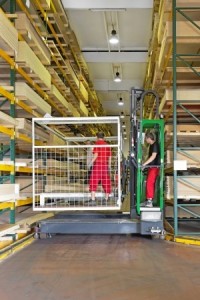 Logistic readiness operations have a number of safety concerns to take into consideration when they are generating a comprehensive safety plan. One of the most neglected areas of logistics safety training tends to be fall protection training. Logistics personnel tend to be rough and ready types who are charged with heavy equipment accident prevention on a daily basis, and this is often a much larger concern than fall prevention. However, according to the IHSA falls are a major cause of injury and death in Canadian workplaces. Having a mandatory fall protection training class could be the difference between a safe work day and a severe on the job injury.
Logistic readiness operations have a number of safety concerns to take into consideration when they are generating a comprehensive safety plan. One of the most neglected areas of logistics safety training tends to be fall protection training. Logistics personnel tend to be rough and ready types who are charged with heavy equipment accident prevention on a daily basis, and this is often a much larger concern than fall prevention. However, according to the IHSA falls are a major cause of injury and death in Canadian workplaces. Having a mandatory fall protection training class could be the difference between a safe work day and a severe on the job injury.
Whether you are using lifts to reach a mezzanine level or need to work on an elevated high line, taking adequate fall protection measures are essential. The most common causes for falls include:
- Failure to wear a proper fall protection lanyard
- Wearing non-standard foot gear and gloves instead of approved non-slip equipment
- Failure to observe point-of-contact requirements for climbing elevated structures
All of these are completely preventable with proper fall protection training. We will look at a few scenarios where this training could save a life.
Scenario One: Steve is a very experienced worker in the operation of his hydraulic lift, so he thinks nothing of hopping up on it and using it to reach the high line and the mezzanine level in his warehouse. He is not afraid of heights and he feels that his lanyard inhibits his ability to move around pallets and cargo. One day he trips on a piece of unsecured cargo net and goes over the side of his hydraulic lift. His lanyard might just have saved his life, and since he was an otherwise conscientious worker he would have attached his lanyard just as he did his other personal protective equipment if he had been trained to.
Scenario Two: Linda is the brand new loader in the warehouse. Since she is inexperienced compared to her peers, she often feels the need to prove herself. That is why whenever her supervisor asks for someone to work on the high line dock, she is the first one to volunteer. However, one day she needs to bring her clipboard filled with load plans and manifests. Instead of securing this in a pouch as she would have learned in fall protection training, she opts to climb with the clipboard and cannot observe the point of contact requirements while climbing the ladder. When one foot slips on the wet ladder she cannot regain her purchase and injures herself in the fall.
Scenario Three: Dan is an equipment operator who has never had an accident. He routinely buys his own safety equipment and opts more for comfort than for the safety requirements. Since he is in his vehicle most of the day and does not need to scale anything on a daily basis, he has never seen the need for heavy rubberized gloves. One day his loader’s hydraulic system locks up, leaving him suspended high in the air. While he is taking the emergency egress ladder his gloves slip and he hits his chin, losing consciousness before he hits the ground.
Although there are other causes of accidents, such as unserviceable equipment continuing to be used past its prime, these are the most common scenarios that lead to major injuries from falls. Taking the time to make fall protection training a mandatory requirement will go a long way toward reducing the instances of these preventable accidents and making sure that your logistics operation is a much safer place to work.

